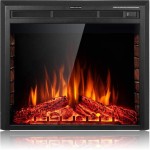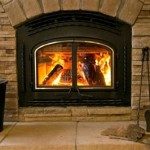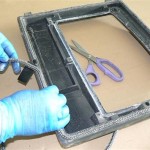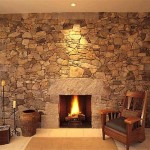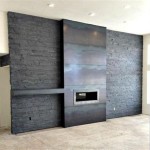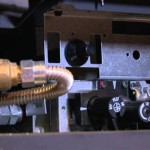How To Hide Cords Above Fireplace
The presence of dangling cords above a fireplace can detract significantly from the aesthetic appeal of the room. Modern entertainment systems often require power and signal connections, which inevitably lead to the challenge of managing these unsightly cables. Addressing this issue involves careful planning and the implementation of various strategies designed to conceal the cords without compromising safety or functionality.
Before undertaking any cord-hiding project, it is crucial to prioritize safety. Power cords should never be run in a manner that could create a fire hazard. This means avoiding contact with flammable materials and ensuring that the cords are not subjected to excessive heat. Consult local building codes and electrical regulations to ensure compliance with safety standards. Professional assistance from a certified electrician may be necessary, particularly if the project involves modifying electrical outlets or wiring.
This article provides a comprehensive guide to different methods for concealing cords above a fireplace, outlining the materials required, the steps involved, and the potential benefits and drawbacks of each approach. The goal is to empower readers to make informed decisions and implement solutions that effectively address their specific needs and circumstances.
Concealing Cords Within the Wall Cavity
One of the most discreet methods for hiding cords above a fireplace is to run them within the wall cavity. This approach involves creating a pathway inside the wall to route the cords from the television or other devices to a power outlet and signal source, such as a cable box or media player, typically located below or to the side of the fireplace. This method offers an aesthetically pleasing result, as the cords are completely hidden from view.
The process begins with identifying the location of the power outlet and signal source. A stud finder is essential to locate the wall studs and avoid drilling into them. Once the stud locations are marked, holes must be drilled into the wall behind the television and near the power outlet. The size of the holes should be large enough to accommodate the cords and any necessary connectors.
A fish tape or wire-pulling tool is then used to guide the cords through the wall cavity. The fish tape is inserted into the upper hole and guided downward until it emerges from the bottom hole. The cords are then attached to the fish tape and pulled back up through the wall. This process may require some patience and dexterity, especially if there are obstructions within the wall cavity, such as insulation or cross braces.
To ensure safety and code compliance, it is imperative to use in-wall rated cables. These cables are specifically designed for use within walls and are fire-resistant. Standard power cords and HDMI cables are not suitable for in-wall installation and should never be used for this purpose. In-wall rated cables have a different jacket composition than common cables, and are designed to limit the spread of fire, preventing combustion in the event of a short circuit. Using a cable not rated for in-wall usage can be a fire hazard and a violation of building codes.
Once the cords are routed through the wall, they can be connected to the television and the power outlet/signal source. The holes in the wall can then be covered with wall plates, which are designed to conceal the openings while providing access to the cords if needed. These wall plates come in various styles and finishes to match the décor of the room.
This method offers a clean and professional look, but it requires some degree of DIY skill and may not be suitable for all wall types. For example, running cords within a brick or stone fireplace surround can be significantly more challenging and may require the assistance of a professional contractor.
Utilizing Cord Concealers and Cable Management Systems
An alternative to running cords within the wall is to use cord concealers and cable management systems. These products are designed to surface-mount the cords along the wall, providing a neat and organized appearance. Cord concealers are available in a variety of styles and materials, including plastic, metal, and paintable versions, allowing them to blend in seamlessly with the surrounding décor.
Cord concealers typically consist of a channel or raceway that attaches to the wall and houses the cords. The cords are placed inside the channel, and a cover is snapped or screwed into place to conceal them. The channel can be cut to the desired length and painted to match the wall color, making it virtually invisible.
Installation of cord concealers is relatively straightforward and requires minimal tools. The first step is to measure the distance between the television and the power outlet/signal source. The cord concealer is then cut to the appropriate length and attached to the wall using screws or adhesive strips. The cords are placed inside the channel, and the cover is secured.
Cable management systems offer a more flexible approach to cord concealment. These systems typically consist of a series of clips, sleeves, or wraps that bundle the cords together and keep them organized. Cable sleeves are fabric tubes that enclose the cords and provide a clean and professional look. Cable wraps are flexible straps that can be wrapped around the cords to keep them bundled together.
Using cord concealers and cable management systems offers several advantages. They are relatively easy to install, they do not require any modifications to the wall, and they provide a flexible solution for managing cords. However, they are not as discreet as running cords within the wall, as the cord concealers are still visible on the surface of the wall.
When selecting cord concealers and cable management systems, it is important to consider the number and size of the cords that need to be concealed. Choose a product that is large enough to accommodate all of the cords without overcrowding them. It is also important to choose a product that is made from durable materials and that is designed to withstand the weight of the cords.
Creative Decorative Approaches to Cord Concealment
Beyond practical solutions like in-wall wiring and cord concealers, creative decorative approaches can also effectively hide cords above a fireplace. These methods focus on integrating the cords into the room's design, making them less noticeable or even turning them into a design feature.
One approach is to use decorative items to strategically block the view of the cords. This could involve placing a tall vase, a potted plant, or a decorative sculpture in front of the cords to obscure them. The key is to choose items that complement the room's décor and that are tall enough to effectively hide the cords.
Another creative approach is to use fabric to conceal the cords. A length of fabric can be draped over the cords and secured to the wall with adhesive hooks or clips. The fabric can be chosen to match the room's color scheme or to add a pop of color and texture. This method can be particularly effective for hiding cords that run along the top of the fireplace mantel.
For a more whimsical approach, consider using decorative cord covers. These covers are designed to look like vines, leaves, or other natural elements. They can be wrapped around the cords to create a natural and organic look. This method can be particularly effective for adding a touch of personality to the room.
Another possibility is to paint the cords the same color as the wall. This can help them blend in and become less noticeable. Use paint that is specifically designed for use on plastic or rubber, and be sure to apply multiple thin coats to avoid dripping.
These decorative approaches offer a creative and personalized way to hide cords above a fireplace. They are relatively inexpensive and easy to implement, and they can add a unique touch to the room's décor. However, they may not be as effective as other methods for completely concealing the cords, and they may require some experimentation to find the right look.
Ultimately, the best method for hiding cords above a fireplace will depend on the specific circumstances of the room, the type of cords that need to be hidden, and the desired aesthetic. By considering the various options outlined in this article, readers can make informed decisions and implement solutions that effectively address their needs and preferences.

How To Hide Tv Wires Above A Fireplace When You Can T Go Through The Wall Homes I Have Made

How To Hide Tv Wires Above A Fireplace When You Can T Go Through The Wall Homes I Have Made

Tv Wall Mount Installation With Wire Concealment Over Fireplace

How To Hide Tv Wires Above A Fireplace When You Can T Go Through The Wall Homes I Have Made

How To Hide Cable Wires When Mounting Tv Over Fireplace Hometalk

How To Hide Wall Mounted Tv Cords Above A Fireplace Without An Electrician In My Own Style

How To Hide Tv Wires Above A Fireplace When You Can T Go Through The Wall Homes I Have Made

How To Mount A Tv Over Brick Fireplace And Hide The Wires Designing Vibes Interior Design Diy Lifestyle

Tv Wall Mount Installation With Wire Concealment Over Fireplace

Hide Cords Of A Tv Mounted Over Fireplace Powerbridge
Related Posts

